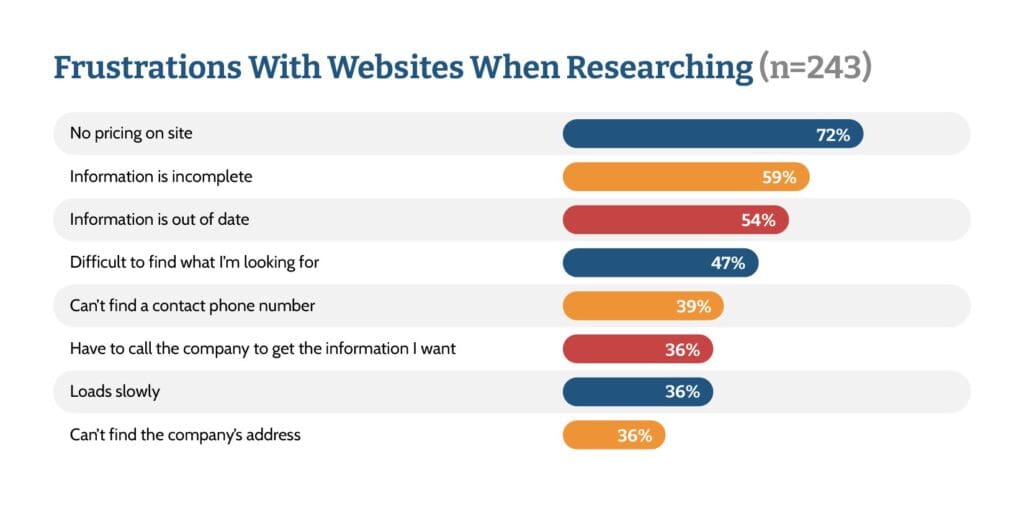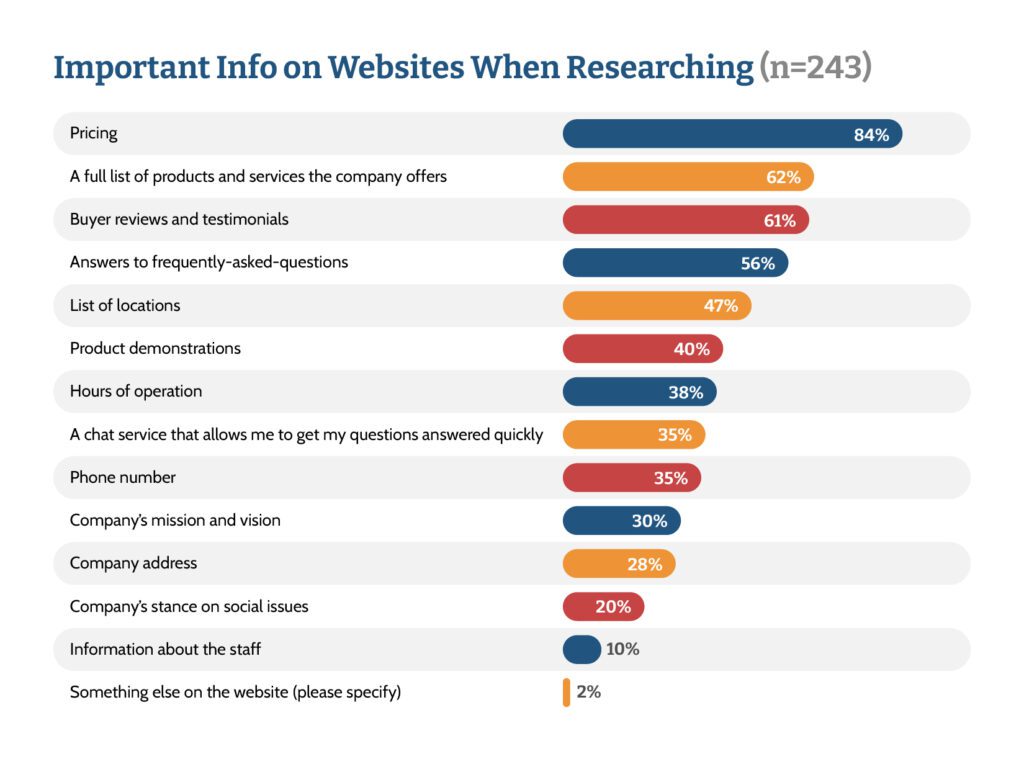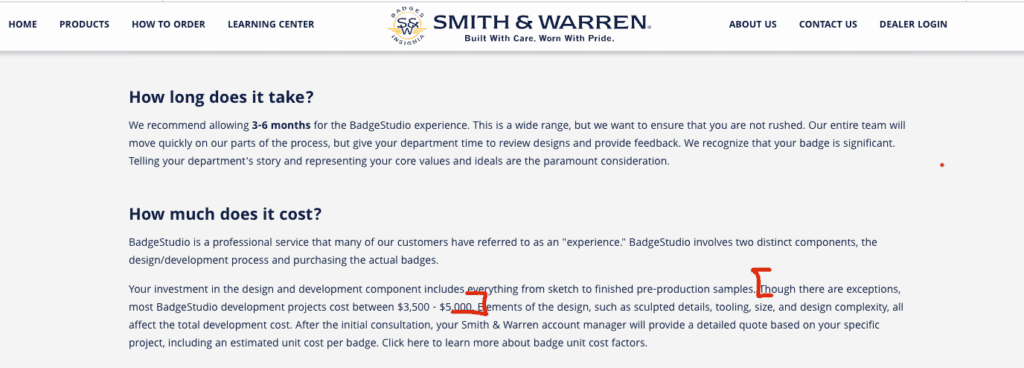Website Content – Should I Put Pricing on My Website?
The most valuable marketing advice for businesses looking to impact sales in the changing digital economy is this: “Put pricing on your website.”
What You’ll Find In This Article
- Why pricing is important
- Top reasons why don’t businesses put pricing on their website
- Suggested pricing prompt
- Ways to add price ranges to your website
- Examples of online pricing articles, tools, and resources
Read This Before You Skim The Rest
The discussion of adding pricing to the website is an emotional one for many. Especially companies with a traditional sales system that requires buyers to talk to the salesperson before getting pricing information.
Buyers want to see pricing on your website and will quickly leave if they don’t see it. The buying habits of today’s customers are changing. Transparency is winning. Sharing is winning. Educating is winning. Adding ways to help buyers understand, at the very least, the price ranges for your products or services is crucial to connect to the needs of today’s buyers.
Studies show that on average, 80% of the buying decision for major purchases is made by the customer today before they walk in your door, fill out an inquiry form, or call a company or salesperson.
Five years ago it was closer to 70%. What will it be five years from now? Not lower.
Buyers are researching on their own to address questions, problems, ratings, reviews, options, and yes, price.
In a recent research study we conducted here in Maine, we found 72% of respondents sharing ‘no pricing’ as the number one frustration of their online research efforts. That same survey revealed that 84% think the pricing on a website is the most important component when looking at companies to choose from.
The data doesn’t lie. Pricing is important.
But still so many are resistant to pricing being on their company website.
If you’re challenged with the notion of adding pricing to your website – or if you’re challenged with trying to convince someone to add pricing to the website – the following points were developed to help you confidently make that decision.

BIGGEST BUYING FRUSTRATION
In a recent audience insight study, we found that 72% of respondents listed “no pricing on website” as the single greatest frustration when researching companies, products, and services online.
Why You Should Put Pricing On Your Website
Trust
At its core, a buyer’s transfer of money to someone they have never met is rooted in trust. Trust comes from being helpful, answering questions, providing information, and demonstrating how you solve problems or help a buyer best fulfill their need.
Trust comes from transparency and authenticity. Think about your own buying experiences. When you feel folks are hiding things from you, does that increase or decrease trust in that person, company, or process?
Your buyers feel the same way.
Sales Efficiency
When talking to business owners and sales managers, I often ask what the top three questions they get regularly are. Guess what is always in the top three? Price.
I then asked how much time they would save and how much more valuable the call would be if the customer already had an idea about the price. Not even the actual price. Just an idea of it. That’s when the lightbulbs tend to come on.
Question – how much time is wasted in our sales process trying to sell features and benefits to buyers that don’t have an idea of what the price range is?
Customer Respect
(See trust.) Today’s buyers have more information, more tools, and more options to help them make decisions on what, where, and who to buy from. Making that decision as easy as possible is what we need to be doing as business owners and sales managers. Knowing that a buyer will make a decision anyway, and helping them make the right one should be the focus of your content efforts.
Competition
We look at competition through two lenses:
- Companies that do what you do
- Companies that buyers see as being able to solve their problems.
For the sake of this paragraph, we’ll focus on the second. You see, buyers don’t have a preconceived notion of what the ‘right’ options are. What a buyer sees as an option may differ greatly from what you see. So it’s on us as businesses to educate buyers as to not only what options are best for them but what the difference is between is, and why they exist.
And the price is one of those differences. For instance, hiring an agency like ours is one option when looking to build a website. And yes, there are other agencies. But included in the list of ‘competitors’ are free and low-cost services, like Wix, GoDaddy, Squarespace, and the local media stations. Even someone’s 17-year-old niece who “knows a lot about computer stuff” is competition.
Explaining the cost difference as well as the value difference helps the buyer better understand their options as well as better attract the right-fit buyers for your business,
WHAT DO THEY WANT?
That same survey revealed ‘pricing’ as the most important info on company websites when researching major purchase decisions.

Why Don’t People Put Pricing On Their Websites?
Competition
Defined in this section as the other companies that do what you do. If we put pricing on the website, the competition will see it.
Question – do you know what your competition charges? The answer is probably yes. Or at least you know the price ranges of your competition. Guess what? They do too. If a customer asks you in person or on the phone, do you do a background check, get their email address, and make them fill out a lead form before giving them a price range?
Heck no. You most likely tell them, “it depends,” and then give them ranges.
So why don’t you do that on the website?
Customized Pricing
Businesses will share with us that pricing just can’t be shown because each sale is developed to the specific need of the customer and requires a very detailed examination and insight process … you get the picture. Maybe this sounds like your business. No two clients are ever the same, and all buyers’ situations differ. Again – “It depends.”
However, surely there are components you can share and ranges that can be developed to help frame the discussion for the potential buyer to help them understand why “it depends” and what “it depends on.”
Value Strategy
You don’t want to share pricing because your approach can’t be defined or boxed in by a package or a number. It’s worth more than people know, and to give the number, you have to explain all you do and why it’s valuable to them. Then and only then can you talk numbers.
This works well when money is no object to the buyer and when your company’s reputation makes you an elite option.
For the rest of us, it’s really a roadblock to building trust with potential buyers. For companies where pricing is complex and has a wide variety, the more that can be explained on your website, the more informed a potential buyer is and the more efficient and valuable the sales call becomes.
We’ll Scare Customers Away With Price
We’ve already identified that today’s buyers are comfortable doing their homework.
And we’ve acknowledged that sales folks would rather talk to prospects with an idea of pricing so they don’t waste valuable time.
So it’s really a win-win if the customer has an idea of the price range before they talk to your company.
They are looking for information. They are looking for answers. And they are looking for someone to trust. And we know they are going to find information.
Two primary questions:
- Are they going to find the right and helpful information?
- Are they going to get that from you or another source?
The idea that providing pricing, combined with other helpful information to help a buyer make an informed decision, will scare customers away runs contrary to everything we know to be true.
Remember – we’re talking about building trust.
Insecurity
I don’t know what will happen if we put cost and pricing on the website. What if the phone stops ringing? What if leads dry up?
There’s no end to the list of worries and anxieties from discussing putting cost and price on the website. But let’s be honest, as business owners and decision-makers, there is rarely a decision that doesn’t have its list of valid doubts and alternatives.
But know this – if you have worries, concerns, or anxieties about adding cost and price to your website, you’re not alone. It’s normal. And guess what? It’s normal for the buyer too.
The good thing is there are ways to approach this topic to help you become more comfortable with the decision and see how it can be helpful to your customers and your business. We outline them for you below.
Suggested Pricing Prompt
Here’s a line that works well as a starting point:
“While there are exceptions and no two companies are exactly the same, we do find that 85% of the XYZ engagements will cost between $X,000 and $X,000.”
Obviously, the percentage and the numbers you use will vary. But the key here is to give the buyer at least a range of what the “average” deal looks like to help frame the conversation.
Here’s an example of that concept being used on the Smith & Warren website.


It Depends on / Price Ranges
The first thing that comes to mind when many businesses hear “put cost and price on the website” is an actual price list of products and services. If you have such a list for your business, then by all means, add it to your website.
But more than likely, you don’t operate that way, so that’s not an option.
Not a problem.
Think about the last time someone asked you, “what does it cost to do xxx”. You may have answered, “It depends…” and then explained the factors involved. You may have given a price range with much room in the middle.
What you did is frame the answer for the buyer and set up the conversation to help narrow in that range based on what you know and what they need.
That answer is perfect for your website as well. The truth is, “it depends” is a real answer. But how you explain what it depends on helps you build trust with the potential buyer.
Options
Chances are, following the “it depends” answer, you have experience in sharing what options are available to impact the cost and price of the product or services. Discussing those options with the buyer helps them see what’s possible but helps them become more informed and see that you are helpful in their search for answers.
Why It Costs More
Knowing the range or average price of something is a good start. Explaining what factors or situations would increase costs is great information for the website. Maybe it’s add-ons, time, supply constraints, travel, size or any number of elements you’ve experienced that increase costs. Communicating and sharing what you know again helps to inform, educate, and form trust with the buyer.
Why It Costs Less
If you can define what factors can increase the average cost of the item or service, then sharing what can help decrease the cost is equally as important.
The Final Test Is Personal
A simple question to close the article out. Put yourself in the buyer’s position. Maybe you’ve been there. You need to make a major purchasing decision for the first time. What do you do? Who do you turn to?
Will the company you choose be the one that hides the information you’re looking for?
Or the one that helps you the most by answering the questions you have, helping you understand your options, and, yes, even telling you what you expect the cost and price to be?
Be the company they trust so you can be the company they chose.
Examples Of Adding Price / Cost To Your Website
Baron Payroll – A New York-based payroll company whose sales process involves many layers of choices, specifics, and details. They’ve developed an online pricing calculator to provide ranges to buyers on the website instantly. Once the estimate is given, there’s an option to set up a call to discuss specifics and get the actual pricing. But the instant pricing calculator helps to define the ranges the business owner would be looking at before setting up a call.
A busy and growing solar installation company in Maine. With electrical prices soaring and insecurity in fuel prices, inquiries have skyrocketed, and the sales team needed help. The buyer’s guide and online resources were developed to give newly interested homeowners the information they needed for purchasing consideration. The online resources also allow sales to respond faster and with more value to new offline inquiries.
Based in New York, Smith and Warren is one of the nation’s largest badge manufacturers and their website includes some nice badge building tools. Still, their sales team receives a number of emails each day around cost of price of specific badges and badge needs. To help respond to these inquiries faster and with greater value, they’ve developed a price and cost article to help explain all the components that go into the manufacturing process.
Based in Bangor, Maine, C&l is a global aviation services and aftermarket-support provider for regional and corporate aircraft specializing in quality parts, service, sales, leasing, maintenance, aircraft refurbishment, and aircraft re-marketing. Their learning center is filled with articles and videos to help customers learn and understand many of the complexities that go in to the process and the pricing of the services they provide.
A boundary survey company serving a growing residential market along the coast of Maine. A typical request for a boundary survey estimate can take a half-hour or more of the company’s time. Making time for estimates and doing the survey work was becoming a challenge, especially as many inquiries were from property owners without understanding boundary pricing. Creating an online tool to help customers get instant price ranges for their individual property needs serves the company well in two ways. It provides instant information to buyers and saves time on estaimte requests. All online inquiries become part of an email list with which the company can continue communicating.
A hot tub, pool, and spa company in Central Maine with workforce issues that look and feel like every other company you know. Workforce challenges, growing demand, and supply chain constraints sometimes make that commitment difficult. So they decided to provide as much information about the buyer process on their website. And this includes pricing, as well as the cost of ownership, maintenance considerations, and what types of hot tubs to consider. This content now helps sales be more efficient and helpful with new client inquiries and has become effective copy for their email marketing and social media efforts.
